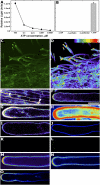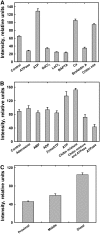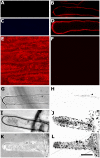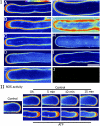Extracellular ATP in plants. Visualization, localization, and analysis of physiological significance in growth and signaling
- PMID: 16963521
- PMCID: PMC1630726
- DOI: 10.1104/pp.106.085670
Extracellular ATP in plants. Visualization, localization, and analysis of physiological significance in growth and signaling
Abstract
Extracellular ATP (eATP) in animals is well documented and known to play an important role in cellular signaling (e.g. at the nerve synapse). The existence of eATP has been postulated in plants; however, there is no definitive experimental evidence for its presence or an explanation as to how such a polar molecule could exit the plant cell and what physiological role it may play in plant growth and development. The presence of eATP in plants (Medicago truncatula) was detected by constructing a novel reporter; i.e. fusing a cellulose-binding domain peptide to the ATP-requiring enzyme luciferase. Application of this reporter to plant roots allowed visualization of eATP in the presence of the substrate luciferin. Luciferase activity could be detected in the interstitial spaces between plant epidermal cells and predominantly at the regions of actively growing cells. The levels of eATP were closely correlated with regions of active growth and cell expansion. Pharmacological compounds known to alter cytoplasmic calcium levels revealed that ATP release is a calcium-dependent process and may occur through vesicular fusion, an important step in the polar growth of actively growing root hairs. Reactive oxygen species (ROS) activity at the root hair tip is not only essential for root hair growth, but also dependent on the cytoplasmic calcium levels. Whereas application of exogenous ATP and a chitin mixture increased ROS activity in root hairs, no changes were observed in response to adenosine, AMP, ADP, and nonhydrolyzable ATP (betagammameATP). However, application of exogenous potato (Solanum tuberosum) apyrase (ATPase) decreased ROS activity, suggesting that cytoplasmic calcium gradients and ROS activity are closely associated with eATP release.
Figures






Similar articles
-
Identification of legume RopGEF gene families and characterization of a Medicago truncatula RopGEF mediating polar growth of root hairs.Plant J. 2011 Jan;65(2):230-43. doi: 10.1111/j.1365-313X.2010.04414.x. Plant J. 2011. PMID: 21223388
-
Annexin 1 Is a Component of eATP-Induced Cytosolic Calcium Elevation in Arabidopsis thaliana Roots.Int J Mol Sci. 2021 Jan 6;22(2):494. doi: 10.3390/ijms22020494. Int J Mol Sci. 2021. PMID: 33419052 Free PMC article.
-
A cell wall-bound adenosine nucleosidase is involved in the salvage of extracellular ATP in Solanum tuberosum.Plant Cell Physiol. 2008 Oct;49(10):1572-9. doi: 10.1093/pcp/pcn127. Epub 2008 Sep 4. Plant Cell Physiol. 2008. PMID: 18772187
-
Extracellular ATP: an unexpected role as a signaler in plants.Trends Plant Sci. 2007 Nov;12(11):522-527. doi: 10.1016/j.tplants.2007.09.003. Epub 2007 Oct 24. Trends Plant Sci. 2007. PMID: 17928260 Review.
-
Apyrases, extracellular ATP and the regulation of growth.Curr Opin Plant Biol. 2011 Dec;14(6):700-6. doi: 10.1016/j.pbi.2011.07.013. Epub 2011 Aug 19. Curr Opin Plant Biol. 2011. PMID: 21855397 Review.
Cited by
-
ATANN3 Is Involved in Extracellular ATP-Regulated Auxin Distribution in Arabidopsis thaliana Seedlings.Plants (Basel). 2023 Jan 10;12(2):330. doi: 10.3390/plants12020330. Plants (Basel). 2023. PMID: 36679043 Free PMC article.
-
Both the stimulation and inhibition of root hair growth induced by extracellular nucleotides in Arabidopsis are mediated by nitric oxide and reactive oxygen species.Plant Mol Biol. 2010 Nov;74(4-5):423-35. doi: 10.1007/s11103-010-9683-7. Epub 2010 Sep 5. Plant Mol Biol. 2010. PMID: 20820881
-
An evolutionary history of P2X receptors.Purinergic Signal. 2009 Sep;5(3):269-72. doi: 10.1007/s11302-008-9127-x. Epub 2008 Nov 18. Purinergic Signal. 2009. PMID: 19015952 Free PMC article.
-
Purinergic signalling: from discovery to current developments.Exp Physiol. 2014 Jan;99(1):16-34. doi: 10.1113/expphysiol.2013.071951. Epub 2013 Sep 27. Exp Physiol. 2014. PMID: 24078669 Free PMC article. Review.
-
Damaged-self recognition in common bean (Phaseolus vulgaris) shows taxonomic specificity and triggers signaling via reactive oxygen species (ROS).Front Plant Sci. 2014 Oct 31;5:585. doi: 10.3389/fpls.2014.00585. eCollection 2014. Front Plant Sci. 2014. PMID: 25400650 Free PMC article.
References
-
- Bibikova TN, Zhigilei A, Gilroy S (1997) Root hair growth in Arabidopsis thaliana is directly by calcium and an endogenous polarity. Planta 203: 495–505 - PubMed
-
- Bodin P, Burnstock G (2001) Purinergic signalling: ATP release. Neurochem Res 26: 959–969 - PubMed
-
- Bowler WB, Buckley KA, Gartland A, Hipskind RA, Bilbe G, Gallagher JA (2001) Extracellular nucleotide signaling: a mechanism for integrating local and systemic responses in the activation of bone remodeling. Bone 28: 507–512 - PubMed
Publication types
MeSH terms
Substances
LinkOut - more resources
Full Text Sources
Other Literature Sources

